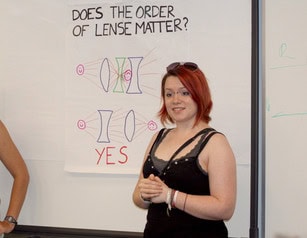
Omega Smith was born and raised in Anchorage, Alaska, and distracted herself for two years at the University of Alaska at Anchorage while pursuing interests in music composition and psychology. Her interest in astronomy dates back to her first astronomy class in high school. Ever since, she has been hopelessly addicted to her passion for the stars, and hopes to let that passion drive her academic and professional career. This has led her to transfer from Alaska to Hawaii to study at the foot of Mauna Kea. She is currently a Physics and Astronomy major at the University of Hawaii at Hilo and is increasingly active in the local astronomical community.
Home Island: Mainland
Institution when accepted: University of Hawaii at Hilo
Akamai Project: Introducing Infrared Imaging Survey (IRIS)
Project Site: Institute for Astronomy, Hilo
Mentor: Klaus Hodapp
There is still much information on bright stars that can be acquired through long time-baseline observations. While they are forming and evolving, stars go through relatively quick changes. A significant change in the magnitude (brightness) of variable stars can occur within 10 years during these star-forming periods. In order to look through the dense gas clouds of star forming regions, infrared wavelengths are used to observe embedded stars. The Infrared Imaging Survey (IRIS) is a 10-year project designed to look at star-forming regions to measure the changes in magnitude of variable stars and compare the results to the photometric calibrations of the previous 2MASS infrared survey. We used the Image Reduction and Analysis Facility (IRAF) software to measure the magnitude of each star using photometry after each image has been reduced through flat-fielding and sky subtraction. The data is acquired by taking a read of the detector at the beginning and after about 20 seconds of integration time. The first set of data from IRIS revealed a residual effect from the detector onto consecutive images. As a result, another read was added as a reset at the very beginning of integration. This read is subtracted from the other reads to cancel out the residual effects. The results from IRIS will provide astronomers with readily available information on star-forming regions in the infrared wavelengths and provide more insight into the formation and evolution of stellar objects.